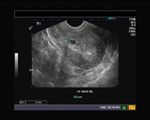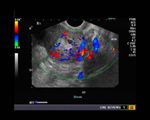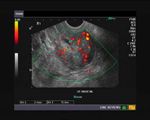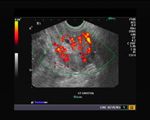What Is Your Diagnosis?
This was a female patient 32 years old, who had irregular menses. She was married for 5 years but unable to conceive.
November 2011 - What's Your Diagnosis?
History:
This was a female patient, 32 years old, who had irregular menses. She has been married for 5 years but was unable to conceive. She also has had severe dysmenorrhea for the past 7 years.
Family History:
She is an only child and her mother did not have any similar history of dysmenorrhea or irregular menses.
Clinical Examination:
On examination, the patient had mild tenderness over the pelvis. Her vital signs were within normal limits.
Imaging:
Sonography of the pelvis revealed:
Transvaginal scan of pelvis
Image-1: sagittal section of uterus

Image-2: sagittal section of uterus:

What are your ultrasound findings based on these two images?
Add your comments below and then continue to the ultrasound Findings.
Ultrasound findings:
The most obvious findings in this sonographic study of the uterus are- the presence of 2 cystic lesions in the myometrium. In image 1, the cyst (almost 8 mm. in size) is in the posterior myometrium in the body of uterus, very close to the junctional zone or endo-myometrial junction. In image-2, the cyst (smaller than the 1st cyst) is present in the fundus of uterus. Are these endometrial cysts or myometrial cysts?
Before we conclude that, let us come to the 2nd finding in this case.
There is an echogenic area in the posterior myometrial wall, that is poorly defined and does not appear to have any mass effect on the endometrium. In image-2, there is what appears to be a marked thickening of the endometrium in the fundus. But examine closely, this is not true thickening of the endometrium, but rather a “pseudo-thickening”, with the echogenic lesion extending into the fundic myometrium.
What condition can produce these appearances on sonography?
Perhaps, we shall see more images of this case.
Image-3:

Image 4:

Images 3 and 4 show marked increase in vascularity in the region of the uterine fundus.
Image 5:

Image 5 shows that the area of maximum hyperemia is within the echogenic lesion (18 x 21 mm. in size) in the posterior myometrium. Note again the prominent cystic areas in the posterior myometrium.

Image 6:
Two small simple cysts are present in the right ovary. This is an incidental finding, and does not appear to have any significant bearing in this case. The left ovary was normal (not shown here).
Add your comments below and then continue to the discussion.
What is your diagnosis?
Clearly we are dealing with a significant pathology in the uterus, producing relatively echogenic and inhomogenous, poorly defined lesions in the posterior myometrium. These lesions do not appear to have mass effects, unlike uterine myomas/ fibroids. There are also relatively large cystic lesions in the myometrium close to the junctional zone or endo-myometrial junction. There appears to be an infiltration of the endometrium into the myometrium in the fundus of the uterus, producing the false appearance of thickening of the endometrium, in this region. What kind of disease can produce these ultrasound findings in the uterus? Clearly, these appearances are seen in only one condition- adenomyosis of the uterus. In addition, the marked hyperemia of the diseased areas is also consistent with adenomyosis.
Add your findings below and continue to the final diagnosis and differential diagnosis.
Final diagnosis: Adenomyosis of the uterus
Differential Diagnosis
Uterine fibroids:
The most important differential diagnosis here is fibroid or myoma of the uterus, which can produce some similar findings. However, fibroids often produce shadowing of the edge of the lesion, are well defined and are rounded in shape with clear mass effects on the endometrium. Besides, fibroids have a characteristic whorled pattern and are poorly vascular. In adenomyosis of the uterus, the lesion (as shown here) is poorly defined and does not produce edge shadowing. Besides the presence of myometrial cysts is a characteristic finding of adneomyosis.
Endometrial carcinoma:
This is one condition that can closely mimic the findings of adenomyosis of the uterus. However the presence of marked thickening of the endometrium and cystic lesions in the endometrium can help differentiate carcinoma from adenomyosis. Proper follow up of the case and histopathological findings can also aid in the diagnosis of endometrial carcinoma.
Uterine contractions:
Contractions of the uterine myometrium may produce similar appearances. However, repeat sonography will show the transient nature of myometrial contractions and help exclude this condition.
Discussion:
Adenomyosis of the uterus is a disease characterized by the presence of heterotopic endometrial tissue in the uterine myometrium, with resultant hyperplasia of the myometrial smooth muscles. This disease is very common in women in the age group from 35 to 50 years. The word adenomyosis is derived from adeno (meaning gland) and myo (meaning muscle- referring to the smooth muscle of the myometrium) and osis (meaning condition or disease). The typical findings of hyperechoic myometrium are the result of presence of endometrial tissue which is characteristically hyperechoic with accompanying smooth muscle hyperplasia (giving the typical hypoechoic appearance). The ultrasound findings resulting from the two changes result in an inhomogenous appearance with either hyperechoic or hypoechoic changes depending on the ratio of the endometrial tissue to the smooth muscle hyperplasia in the myometrium.
We challenge you to stump your colleagues!Send us your images and diagnosis.
References:
References:
1) Radiographic,Ultrasound and MR findings in Adneomyosis
2) Wikipedia, Adenomyosis
3) Medscape,Adenomyosis imaging
4) http://www.ultrasound-images.com/uterus.htm#Adenomyosis_of_uterus (imaging of adenomyosis)
S1E4: Dr. Kristina Adams-Waldorf: Pandemics, pathogens and perseverance
July 16th 2020This episode of Pap Talk by Contemporary OB/GYN features an interview with Dr. Kristina Adams-Waldorf, Professor in the Department of Obstetrics and Gynecology and Adjunct Professor in Global Health at the University of Washington (UW) School of Medicine in Seattle.
Listen
